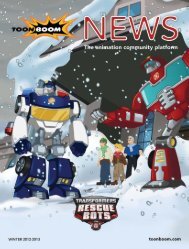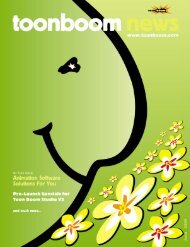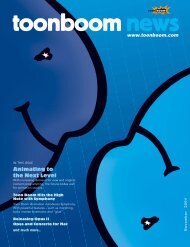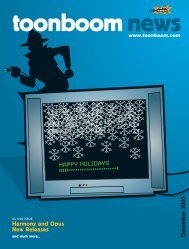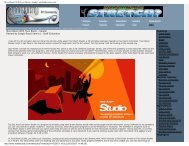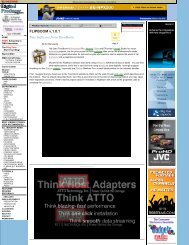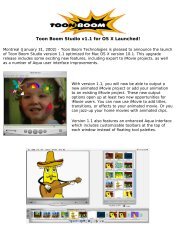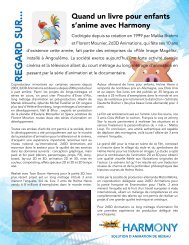MAKE YOUR PRODUCTIONS FLY - Toon Boom Animation
MAKE YOUR PRODUCTIONS FLY - Toon Boom Animation
MAKE YOUR PRODUCTIONS FLY - Toon Boom Animation
Create successful ePaper yourself
Turn your PDF publications into a flip-book with our unique Google optimized e-Paper software.
toonboomnews<br />
www.toonboom.com<br />
<strong>MAKE</strong> <strong>YOUR</strong> <strong>PRODUCTIONS</strong> <strong>FLY</strong><br />
with <strong>Toon</strong> <strong>Boom</strong>’s <strong>Animation</strong> Software Solutions<br />
April 2006
Image courtesy of Universal Pictures and Imagine Entertainment<br />
<strong>Toon</strong> <strong>Boom</strong>’s leading animation<br />
software solution Opus, has significantly<br />
contributed to the feature film<br />
production of Curious George.<br />
Universal Pictures and Imagine Entertainment<br />
ANIMATION SOFTWARE SOLUTIONS<br />
THAT <strong>MAKE</strong> <strong>YOUR</strong> <strong>PRODUCTIONS</strong> <strong>FLY</strong><br />
<strong>Toon</strong> <strong>Boom</strong> roared into 2006 by attending Nasscom’s <strong>Animation</strong> India 2006 event in Mumbai on January 13, and<br />
the National Association of Television Program Executives (NATPE) conference and exhibition in Las Vegas, from<br />
January 24 to 28. Keeping up the pace we then went to the KidScreen Summit in New York, from February 8 to<br />
10, and Tech Forum San Diego and the American Association of School Administrators Conference, running<br />
concurrently from February 23 to 25. This was quickly followed by FRAMES in Mumbai, from March 22 to 24, and<br />
the Tokyo International Anime Fair, on March 23 and 24.<br />
_____________________________________________________________________________________________________________________________________________________________________________________<br />
Keeping this pace on track the <strong>Toon</strong> <strong>Boom</strong> team will be attending MIPTV in Cannes, from April 3 to 7, Booth C1.05;<br />
NAB in Las Vegas, from April 24 to 27, Booth C10512; and MIFA in Annecy, from June 7 to 9, Booth 2.03. Jump<br />
on board! We’ll be delighted to meet you at one of the events! At the same time, the team conducted road shows<br />
in Brazil, Singapore, Thailand, the Philippines, China, Korea and Taiwan.<br />
_____________________________________________________________________________________________________________________________________________________________________________________<br />
In Brazil, the <strong>Toon</strong> <strong>Boom</strong> team provided training seminars to 39 independent animators in São Paulo and Rio de Janeiro.<br />
The seminars were extremely successful, with all of the participants becoming certified for <strong>Toon</strong> <strong>Boom</strong> Solo and<br />
most of them purchasing the software. Organized with the assistance of the Brazilian Animators Association, the<br />
courses were held at 2DLab in Rio de Janeiro and two technical colleges, ESPM also in Rio de Janeiro and SENAC<br />
in São Paulo. Both of the colleges trained at least one of their teachers, who will transfer their knowledge to create<br />
a <strong>Toon</strong> <strong>Boom</strong> environment amongst new graduates. Considering the Brazilian community’s enthusiastic response,<br />
<strong>Toon</strong> <strong>Boom</strong> has played an active role in the Co-producing with Canada trade mission at the end of March and<br />
organized additional workshops for 150 Brazilian producers.<br />
_____________________________________________________________________________________________________________________________________________________________________________________<br />
In Singapore, the team organized workshops and on-site meetings with the private and education sectors, in conjunction<br />
with the Canadian Trade Commissioners Service and the Singapore Media Development Authority.<br />
<strong>Toon</strong> <strong>Boom</strong> is extremely grateful for their endeavors and thanks them for making this trip such a success.<br />
_____________________________________________________________________________________________________________________________________________________________________________________<br />
<strong>Toon</strong> <strong>Boom</strong> is proud to spotlight the theatrical release of Curious George in February 2006. <strong>Toon</strong><br />
<strong>Boom</strong>’s leading animation software solution Opus, has significantly contributed to the feature film<br />
production of this globally known character. Produced by Universal Pictures and Imagine<br />
Entertainment, the feature offers an all-new adventure based upon the beloved tales of George,<br />
the inquisitive little guy with an insatiable taste for action. “For more than 65 years, this little monkey<br />
has captured the hearts and minds of so many people of all ages and we are very proud that<br />
<strong>Toon</strong> <strong>Boom</strong> has been involved in the making of this fantastic 2D feature for the big screen,” shared<br />
Joan Vogelesang, President and Chief Executive Officer at <strong>Toon</strong> <strong>Boom</strong>. <strong>Toon</strong> <strong>Boom</strong> recommends<br />
that all animation lovers go see this movie!<br />
2 toonboom news / april 2006
TECHNOLOGY NEWS<br />
<strong>Toon</strong> <strong>Boom</strong> Studio<br />
Now Supports Intel in Macs<br />
On March 15, <strong>Toon</strong> <strong>Boom</strong><br />
<strong>Animation</strong> Inc. announced<br />
the release of <strong>Toon</strong> <strong>Boom</strong><br />
Studio V3 for Apple’s<br />
new generation of Macs,<br />
featuring Intel processors.<br />
Powered by the most<br />
advanced Intel chip, the new Macs will run <strong>Toon</strong> <strong>Boom</strong><br />
Studio at peak performance. To help customers easily<br />
identify that the software runs on both Intel and<br />
PowerPC-based Mac computers a Universal logo will<br />
be displayed on <strong>Toon</strong> <strong>Boom</strong> Studio packaging and<br />
Web pages. “<strong>Toon</strong> <strong>Boom</strong> is totally committed to the<br />
Mac community and has made a priority to port <strong>Toon</strong><br />
<strong>Boom</strong> Studio to Apple’s universal binaries. As the first<br />
in a series of <strong>Toon</strong> <strong>Boom</strong> applications optimized for<br />
the new CPU, <strong>Toon</strong> <strong>Boom</strong> Studio offers great performance<br />
to create digital and cut-out animations for TV,<br />
HDTV, video, the Web, PDAs and the iPod. We look<br />
forward to seeing what professional animators, hobbyists<br />
and schools will be creating with this latest<br />
release,” shared Joan Vogelesang, President and Chief<br />
Executive Officer at <strong>Toon</strong> <strong>Boom</strong>. The <strong>Toon</strong> <strong>Boom</strong><br />
Studio V3 Universal Binary release is ready to ship and<br />
can be purchased at www.toonboom.com. All current<br />
<strong>Toon</strong> <strong>Boom</strong> Studio V3 Mac customers are entitled to<br />
download this latest version at no charge. The next<br />
<strong>Toon</strong> <strong>Boom</strong> application available for Apple’s new Intel<br />
processors will be <strong>Toon</strong> <strong>Boom</strong> Studio Express V3, ready<br />
to ship on April 14, 2006.<br />
Podcast Your <strong>Animation</strong> !<br />
Now you can easily save your animation for podcasting using <strong>Toon</strong> <strong>Boom</strong>’s products. Podcasting is an emerging<br />
technology that allows you to show media content on your iPod, including news, TV shows, and, of course, animations<br />
powered by <strong>Toon</strong> <strong>Boom</strong>.<br />
What better way to showcase your animated content anywhere<br />
you go and reach an audience of millions. Use this<br />
lightweight device to share your heavyweight <strong>Toon</strong> <strong>Boom</strong><br />
animations with your friends and family.<br />
It’s easy: Learn how to create podcast-ready animation,<br />
viewable on your iPod.<br />
It’s fast: Learn how to podcast your animation on the<br />
Internet, via a Web feed, using either RSS or Atom syndication<br />
standard formats.<br />
You’ll need:<br />
➜ One of <strong>Toon</strong> <strong>Boom</strong>’s animation software solutions<br />
➜ Apple iTunes 6.0.2.23 or higher<br />
➜ An iPod for portable playback or Web server space for<br />
podcasting<br />
Here is how to export your <strong>Toon</strong> <strong>Boom</strong> project to make it<br />
podcast-ready. This is the supported iPod video format as<br />
described on Apple website:<br />
H.264 video<br />
File formats: M4V, MP4 and MOV<br />
Video: Up to 768 Kbps, 320 x 240 pixels, 30 frames per second,<br />
Baseline Profile up to Level 1.3<br />
Audio: AAC-LC up to 160 Kbps, 48 KHz, stereo audio<br />
MPEG-4 video<br />
File formats: M4V, MP4 and MOV<br />
Video: Up to 2.5 Mbps, 480 x 480 pixels, 30 frames per second,<br />
Simple Profile<br />
Audio: AAC-LC up to 160 Kbps, 48 KHz, stereo audio<br />
You can use these settings directly in <strong>Toon</strong> <strong>Boom</strong>’s products<br />
to export your animation. If you don’t know what the<br />
above information means, don’t worry, iTunes will convert<br />
it for you. Simply follow these instructions:<br />
1. Export your animation from one of <strong>Toon</strong> <strong>Boom</strong>‘s products<br />
as a QuickTime file. Using the H.264 is recommended but<br />
not required. This codec is available in <strong>Toon</strong> <strong>Boom</strong>‘s<br />
products after installing the free QuickTime Player 7.<br />
2. Open iTunes (6.0.2.3 or higher).<br />
3. Click the file menu and select Add a File to Library.<br />
4. Browse to the location where you saved your animation<br />
and select it to open it.<br />
5. In iTunes, in the left panel select Videos (you should see<br />
your animation in the right panel).<br />
6. Right-click on your animation and select Convert<br />
Selection for iPod. iTunes will duplicate your animation<br />
video with the proper settings for podcasting.<br />
You now have a M4V (MPEG-4 Video) file ready for podcasting.<br />
Drag your converted animation to your iPod in<br />
iTunes to transfer your animation<br />
to your iPod. You will<br />
use this new video file for<br />
podcasting later in this article.<br />
To play back your animation,<br />
on your iPod, select<br />
Video, then Films and the<br />
name of your video. Enjoy!<br />
toonboom news / april 2006 3
HARMONY NEWS<br />
Image courtesy of 2DLab<br />
Image courtesy of Enarmonia<br />
2DLab is an animation studio in Rio de Janeiro, Brazil. Over<br />
the past three years, the studio has won the Liv Ullmann<br />
Peace Award and First Prize in the Animated Television<br />
Production category at the Chicago International Children’s<br />
Film Festival as well as several other awards. 2DLab is currently<br />
developing its first animated series, in co-production<br />
with a Canadian producer. They have just certified all<br />
their staff in <strong>Toon</strong> <strong>Boom</strong> Harmony. “We are currently stress<br />
testing the product and are very excited with the results.<br />
Our initial assessment is that Harmony is very wellsuited<br />
to our specific style of animation and we<br />
expect to have a 15-20% boost in productivity without<br />
loosing the highly emotional style of animation<br />
that has become our trademark,” shared Andre<br />
Koogan Breitman, executive producer at 2DLab. “We are<br />
always looking for new challenges and new co-production<br />
partners. We work exclusively with 2D animation.” 2DLab<br />
is part of the Delta Publishing Group, a group of four<br />
publishing houses that over the last 75 years, has published<br />
more than 4,000 titles that are currently in print, focusing<br />
on college-level textbooks and reference works, including<br />
the World Book and Larousse encyclopedias.<br />
____________________________________________________________________________________________________________________________________<br />
Established in Turin in 1999, Enarmonia is one of the main<br />
service companies in European animation. It plays an active<br />
role in every stage of animation, realizing character and background<br />
design, storyboarding, layout, digital and traditional<br />
background, high quality traditional animation, 2D<br />
and 3D digital animation, 2D/3D integration, compositing<br />
and special effects. Enarmonia is the first European company<br />
that has achieved the Quality Management System<br />
Certification UNI EN ISO 9001:2000 in the animation field.<br />
Enarmonia has worked with Lanterna Magica on Gino the<br />
Chicken, and also on Neve e Gliz, a series developed for<br />
the Turin Winter Olympics. Both of the 52 one-minute<br />
episode series were produced using <strong>Toon</strong> <strong>Boom</strong>’s software.<br />
Employing a permanent staff of internal artists the<br />
studio is about to start a new digital production called<br />
Uffa, che Pazienza using <strong>Toon</strong> <strong>Boom</strong> Harmony. This series<br />
of 52 five-minute episodes will be a combination of cut-out<br />
and traditional style to be co-produced with RAI/Motus<br />
and a German partner. Enarmonia is also developing a digital<br />
animation program at Instituto Europeano de Design<br />
where <strong>Toon</strong> <strong>Boom</strong> Harmony will be part of the curriculum.<br />
“We have decided to buy Harmony because we wanted<br />
to develop the digital animation in our studio and we<br />
think that Harmony is the software which corresponds<br />
perfectly to the needs of our animators,” shared Federica<br />
Maggio, Managing Director at Enarmonia.<br />
____________________________________________________________________________________________________________________________________<br />
Have you ever seen a sweet and charming story with lovable<br />
characters? What about a colorful and one-of-a-kind movie?<br />
Have you ever worked on a production you would be<br />
proud to show children all over the world, bringing fun<br />
and joy to everyone? These are the reasons why Neomis<br />
<strong>Animation</strong> is so proud to have been the only European<br />
studio that contributed to the making of Curious George.<br />
Neomis <strong>Animation</strong> thanks Universal Cartoon Studios for<br />
this unforgettable experience and salutes the <strong>Toon</strong> <strong>Boom</strong><br />
Opus crew for their kind support. Neomis <strong>Animation</strong> has<br />
been in action for two years, located right in the heart of<br />
Paris, France. Their team of artists emerges from the Walt<br />
Disney Feature <strong>Animation</strong> France crew, which contributed<br />
to ten feature films, including The Hunchback of Notre<br />
Dame, The Emperor’s New Groove and Tarzan. Neomis<br />
<strong>Animation</strong> is a young studio, passionate about animation—<br />
their talented and experienced crew speaks for itself!<br />
____________________________________________________________________________________________________________________________________<br />
The best part of the AMC Theatres’ Soar cinema commercial<br />
is that you believe it is a real trailer for an actual feature<br />
film because it was done by feature directors Elliot M.<br />
Bour and Saul Blinkoff who worked on such films as Disney’s<br />
Lion King and Aladdin. The two are represented by New<br />
York’s Curious Pictures. Having just completed a substantial<br />
sequence of the Saul & Elliot-directed and Disneyproduced<br />
Kronk’s New Groove. Saul & Elliot / Curious<br />
Pictures approached Yowza <strong>Animation</strong> to produce the<br />
animation through final composite. Yowza <strong>Animation</strong> was<br />
established in Toronto, Canada in 1996 by Claude Chiasson<br />
and specializes in high quality feature films, television<br />
series and commercials. Roger Chiasson, renowned ani-<br />
4 toonboom news / april 2006
Image courtesy of Curious Pictures and Yowza <strong>Animation</strong><br />
Image courtesy of Label-Anim<br />
mation director and Claude where both involved heavily<br />
in preproduction and final production of the spot. Yowza<br />
traditionally animated Soar and used Opus for ink, paint<br />
and composite. Sonya Carey was in charge of the digital<br />
division using internal toolsets. Sonya was able to produce<br />
a high quality final product, in a rather short period of<br />
time complete with computer-generated special effects.<br />
“The scan and ink-and-paint are so user-friendly that it<br />
was easy to bring in support staff at the last minute and<br />
have them trained fairly quickly. There were some camera<br />
moves that were rather specific, so, with the use of the<br />
scene graphs, it was really easy to control the camera and<br />
the artwork to give the illusion of flight. Instead of having<br />
to create specific motion by moving objects or the camera<br />
frame by frame, Opus allows you to make fantastic<br />
camera moves with only two or three key frames.<br />
These are important features when you are short on time.”<br />
____________________________________________________________________________________________________________________________________<br />
After 12 years as founder<br />
and manager of Animage,<br />
a subsidiary of the AB<br />
Group, Thibaut Chatel decided<br />
to open his own animation<br />
studio, Label-Anim,<br />
in 2003. Early 2005, Guillaume<br />
Galliot, who was previously<br />
in charge of the<br />
audiovisual division at<br />
Groupe Dargaud, joined<br />
the team as executive<br />
producer. Since then, the<br />
studio has produced several<br />
animated series and has started the production of<br />
Kung-Foot, a new 26-episode 26-minute series for TF1,<br />
using <strong>Toon</strong> <strong>Boom</strong> Opus. “<strong>Toon</strong> <strong>Boom</strong> Opus is a very wellknown<br />
and established animation software. As we work<br />
with Hosem <strong>Animation</strong> Studio in China, we wanted to be<br />
fully compatible with them so the time was right to adopt<br />
Opus. Also, we plan to take advantage of its wide array of<br />
powerful features, among them the lip sync which we find<br />
quite interesting,” shared Stéphane Gaultier.<br />
____________________________________________________________________________________________________________________________________<br />
San Mao Joins the Army is a new media cartoon drama<br />
produced by the Institute of China Traditional Opera<br />
Academy, which was awarded the second prize at the fifth<br />
National Children’s Drama exhibition. Professor Yu Shaofei<br />
shared: “It utilizes the fictitious techniques of expression<br />
that perfectly combines the animation and real people.<br />
During the creation process of this drama, we decided to use<br />
<strong>Toon</strong> <strong>Boom</strong> Harmony to create the animated portion of this<br />
new media drama project<br />
completely paperless.<br />
Some sceneries<br />
included 3D technology<br />
as well, resulting in<br />
a more powerful presence<br />
and enhanced<br />
story on stage thanks<br />
to the visual reality<br />
technique.”<br />
____________________________________________________________________________________________________________________________________<br />
Since 2003, Firehorse Films has been producing bro’Town,<br />
New Zealand’s first prime-time adult animation—an<br />
unashamedly suburban, non-PC satire. Joined by the<br />
Naked Samoans (Oscar Kightley, David Fane, Shimpal<br />
Lelisi and Mario Gaoa) and by animation director Maka<br />
Makatoa and designer Ant Sang, the show’s producer,<br />
Elizabeth Mitchell, has experienced great success with the<br />
series. The labor-intensive 2D animation style means that a<br />
team of about 150 people, both at Firehorse and at their<br />
satellite studio in India, are needed for each episode. Each<br />
bro’Town show has between 16,000 and 24,000 drawings<br />
and takes around six months to complete. bro’Town uses<br />
<strong>Toon</strong> <strong>Boom</strong> Opus to make the show and this year has<br />
increased its digital capacity. “<strong>Toon</strong> <strong>Boom</strong> was instrumental<br />
in hooking Firehorse up with their Indian partners<br />
DQ Studios. For Series 3, we are hoping to work with new<br />
Australian studio TUI Studios, again with the help of <strong>Toon</strong><br />
<strong>Boom</strong> and its Australian dealer Adimex,” shared Elizabeth.<br />
bro’Town is screening on Foxtel’s comedy channel in<br />
Australia, on Air New Zealand’s Inflight service, on Fiji TV<br />
and will soon air on Cartoon Network Latin America.<br />
Image courtesy of Firehorse Films<br />
Image courtesy of Institute of China Traditional Opera Academy<br />
toonboom news / april 2006 5
SOLO NEWS<br />
Image courtesy of Sophia Hilton Foundation<br />
Image courtesy of HGN Productions<br />
The Sophia Hilton Foundation of Canada is animating a<br />
fifty-two episode story series, in collaboration with the<br />
Shastri Indo-Canadian Institute. The entire project is being<br />
executed using <strong>Toon</strong> <strong>Boom</strong>’s Solo software package. The<br />
Ponnivela epic depicts the many challenges faced by a<br />
16th century agricultural family from South India over a<br />
period of three generations. It is hoped that the animated<br />
version of this legend can be used to inspire South Indian<br />
village artists and provide them with new techniques and<br />
ideas for the communication of traditional story content. It<br />
will also be used in schools and universities. The project<br />
designers are striving to remain faithful to the folk art and<br />
folk music of this particular cultural region. All one hundred<br />
plus characters are being built and rigged using cut-out animation<br />
techniques and Indian “folk art” stylistics. The lead<br />
animator comments: “This is EXCELLENT software! I<br />
have had extensive experience with Maya and switching<br />
over to Solo’s 2D platform has been a delight. The<br />
design and staging capabilities of Solo meet the expectations<br />
of a 3D animator very well. I especially like the ability<br />
to move the camera in so many ways, including ‘flying’<br />
through the layers of a scene,” shared Ravichandran, Lead<br />
Animator, Legend of Ponnivela Project.<br />
____________________________________________________________________________________________________________________________________<br />
HGN Productions has been in the animation business for<br />
sixteen years and started producing Disney series (Goof<br />
Troop and Aladdin) in Brazil back in 1990. During that time,<br />
they started their animation<br />
training program<br />
to increase and<br />
speed up production<br />
for the series.<br />
They have trained a<br />
lot of animators the<br />
traditional way and<br />
now they are adopting<br />
<strong>Toon</strong> <strong>Boom</strong> Solo<br />
Image courtesy of Angel Magic and Kanya <strong>Animation</strong><br />
in their classes so the students can learn the new trends and<br />
technologies. The studio is also developing local TV series<br />
and feature animation projects using <strong>Toon</strong> <strong>Boom</strong> software.<br />
“Coming from a traditional animation background using<br />
Oxberrys and cels not too long ago, it is just amazing what<br />
Solo can do to increase production values and speed production<br />
time,” shared Haroldo Guimaraes Neto, president<br />
at HGN Productions.<br />
____________________________________________________________________________________________________________________________________<br />
Angel Magic, a multimedia agency in Thailand, in partnership<br />
with Kanya <strong>Animation</strong>, started its first international<br />
animation project, called The Tiger Heart. This small 2D<br />
studio began using <strong>Toon</strong> <strong>Boom</strong> Studio for TV commercials<br />
and all other new public and private sector media projects.<br />
As 3D animation production is getting more popular in<br />
Thailand, Angel Magic is one of the four studios who still<br />
produce traditional animation. “As a professional animation<br />
studio with great experience, we decided to become an<br />
animation tutor using <strong>Toon</strong> <strong>Boom</strong> products. We set up a small<br />
class in our studio to educate young people to create their<br />
own short animation projects. We find that <strong>Toon</strong> <strong>Boom</strong>’s<br />
products are excellent for teaching the new generation<br />
the best animation technology,” shared Vethit Thongchantr,<br />
Managing Director at Angel Magic. The Tiger<br />
Heart is an action fantasy story that blends<br />
exotic Thai design with a world famous<br />
sport: Thai Boxing. It is about four different<br />
characters of four races (animal,<br />
robotic, spiritual and human) fighting<br />
for the heart of the tiger. “The project<br />
shows the unlimited 2D animation<br />
ability of <strong>Toon</strong> <strong>Boom</strong> Studio to<br />
rotate the camera view around<br />
the character as 3D does.”<br />
Angel Magic has recently<br />
added <strong>Toon</strong> <strong>Boom</strong> Solo<br />
to its toolkit to benefit<br />
from its more advanced<br />
capabilities in<br />
its upcoming<br />
project.<br />
6 toonboom news / april 2006
TOON BOOM STUDIO NEWS<br />
Image courtesy of Matt Dell<br />
On September 23, 2005, Brad Paisley launched his<br />
headlining Brad Paisley Time Well Wasted tour, featuring<br />
Sara Evans and special guest Sugarland, with sellout performances<br />
in major cities across the United States,<br />
including Chicago, New York, and Los Angeles. Brad has<br />
been playing music since he was eight years old and got<br />
into animation only later on. For his previous album,<br />
Mud on the Tires, Brad played an instrumental piece<br />
with the band, and his first cartoon running behind them<br />
on the big screens was a big hit. In the current album,<br />
Time Well Wasted, they have another four-minute fast<br />
instrumental piece for which he developed a new cartoon.<br />
He created a cartoon version of himself and uses<br />
this character interactively with the crowd. “I love <strong>Toon</strong><br />
<strong>Boom</strong> Studio. I can honestly say that it is enhancing my<br />
career in many ways. I travel a lot and with almost all my<br />
traveling time on planes or by bus, I spend it animating,<br />
creating new content for the show. To promote my next<br />
single, I am planning to email radio programmers a personalized<br />
animated message that will include a cartoon<br />
version of themselves. I know them all personally so it<br />
will be a more creative way to promote my new song<br />
and have them play it on the radio,” shared Brad.<br />
As featured in our November 2005 eNewsletter, the Youth<br />
Digital Media and Arts CyberSchool announced its newest<br />
course: Creating and Animating Video Game Characters<br />
(VGD103). This course teaches how to create and animate<br />
video game characters using <strong>Toon</strong> <strong>Boom</strong> Studio.<br />
Characters are then imported into Clickteam’s Multimedia<br />
Fusion video game design software. Since then, the online<br />
course has been adopted by several schools and learning<br />
centers throughout the United States. Filmed at the Julian<br />
Charter School in San Diego, California, the CyberSchool<br />
has produced a special video promoting girls and technology<br />
as well as how video game design can be implemented<br />
in core curriculum as early as the Grade 3 right up to high<br />
school. This video also shows how to apply animation and<br />
gaming to a school assignment, such as marine biology.<br />
Check out the video posted at http://www.thelcg.com/yd<br />
macs_video_game_design_in_education.wmv. This is edutainment<br />
at its best!<br />
____________________________________________________________________________________________________________________________________<br />
Rum Runners’ buxom adult cartoon star Brickhouse Betty<br />
is one of the most popular characters on the Web. Her<br />
ensemble cast has developed its own cult following which<br />
includes Santa, the Easter Bunny, J.D. the Jungle Dude, the<br />
infamous Grandpa Slappy and many other odd yet endearing<br />
characters. Betty’s recent short Stormy Bangs Betty!,<br />
which co-stars adult icon Stormy Daniels, was featured on<br />
Wicked Pictures’ DVD Camp Cuddly Pines Powertool Massacre<br />
which won the 2006 AVN Award for Best DVD Extras.<br />
She can now be seen in Flash, on iPod, PSP, DVD and on<br />
mobile phones. “The cartoons begin as traditional animation<br />
drawings and are then imported into <strong>Toon</strong> <strong>Boom</strong> Studio and<br />
prepared for animation. Rum Runners uses <strong>Toon</strong> <strong>Boom</strong><br />
exclusively for this conversion because of its incredible ability<br />
to maintain the integrity of<br />
the original illustration while<br />
allowing tweaks that can<br />
simulate the inking process.<br />
In a small studio, that’s a lifesaver.<br />
Without <strong>Toon</strong> <strong>Boom</strong>,<br />
Betty and cast just wouldn’t<br />
look the same,” shared Sven<br />
from Rum Runners Studios.<br />
Image courtesy of Rum Runners<br />
Image courtesy of Rum Runners<br />
toonboom news / april 2006 7
STUDIO CASE STUDY<br />
Images courtesy of Ralph Bakshi<br />
WITH 53 years of experience in the animation industry,<br />
Ralph Bakshi has an impressive track record. This<br />
famous animation director, animator, cartoonist and writer<br />
worked on a remarkable number of features, TV series and<br />
specials–all based on hand-drawn animation.<br />
Ralph Bakshi was born in 1938. He grew up in Brooklyn,<br />
New York, and went to the High School of Industrial Arts,<br />
now called the High School of Art and Design. After graduation,<br />
armed with a cartooning diploma, he went to work<br />
at Terrytoons animation studio in New Rochelle, where he<br />
started as a cel painter. He quickly became an animator,<br />
working on major characters like Mighty Mouse, Heckle and<br />
Jeckle, Deputy Dawg. Ralph became the director on these<br />
shows at 25; he was appointed creative director of the studio<br />
by CBS when he created and wrote The Mighty Heroes.<br />
Ralph accepted the position of producer and director of<br />
Paramount Cartoon Studios, which had been the old Max<br />
Fleischer Studio, in 1967. There he did four theatricals:<br />
Marvin Digs, Mini Squirts, Super Basher and Bop, and<br />
The Fiendish Five. He hired Mort Drucker, Wally Wood,<br />
Jack Davis, Joe Kubert, Jim Steranko, Gray Morrow and<br />
Roy Krenkel. After founding his own studio, Steve<br />
Krantz Productions asked him to take over direction<br />
and production of Rocket Robin Hood, and<br />
then, the Spider-Man series.<br />
In the ‘70s, Ralph moved into animated features<br />
with Fritz the Cat, which he wrote and<br />
directed in 1971. He created, wrote, and directed<br />
Heavy Traffic, released in 1973. In the same year,<br />
he established Bakshi Productions, Inc. There he<br />
enjoyed working with key names from the history of animation:<br />
Jim Tyer, Virgil Ross, Irv Spence, John Sparey, Manny<br />
Perez, Bob Carlson, Jonny Vita, and Ed Barge. He created,<br />
wrote and directed Coonskin (Street Fight) with producer Al<br />
Ruddy (The Godfather, The Longest Yard), released in 1975.<br />
Wizards was created, written, directed and produced<br />
by Ralph and released in 1977. He next directed the 1978<br />
version of Lord of the Rings, using the rotoscoping technique.<br />
At this point, he started painting seriously, preparing<br />
for a show at the Ulrica Cantor Gallery in Los Angeles. Hey<br />
Good Looking was also created, written and directed and<br />
released by Ralph in 1980. American Pop was written,<br />
directed and produced for release in 1981; then Fire and<br />
Ice was created, directed, and co-produced in 1983 with<br />
world-renowned fantasy illustrator Frank Frazetta. Two<br />
years later, Ralph did a live-action and animated video for<br />
the Rolling Stones called The Harlem Shuffle.<br />
The next year, he began Mighty Mouse: The<br />
New Adventures for the 1987 and 1988 TV<br />
seasons with John Kricfalusi who went on to do<br />
Ren and Stimpy. In the summer of 1987, Ralph<br />
had another solo art show at the Philip Dash<br />
Gallery in New York City, then his first liveaction<br />
short, This Ain’t Be-bop, debuted on<br />
PBS American Playhouse, which he wrote and<br />
directed. It starred Harvey Keitel, and was a<br />
look at the values of the Beat generation. Tattertown, a<br />
Christmas Special, was done at the same time. The Butter<br />
Battle Book special was done with Ted Geisel (Dr. Seuss) in<br />
1989. Cool World, a mix of live-action and animation, featuring<br />
Brad Pitt and Kim Basinger, was directed by Ralph<br />
and released by Paramount in 1991. Ralph wrote and<br />
directed, the live-action TV movie The Cool and The Crazy,<br />
starring Alicia Silverstone and Jared Leto, which filmed in<br />
Los Angeles in 1994 for Showtime. In 1997, he created the<br />
animated science fiction detective HBO series, Spicy City.<br />
In 1998, his fine art was showcased once again at the<br />
Nardin Gallery in New York City. His next shows were at<br />
Animazing Gallery in Soho in the spring of 2000 and 2001.<br />
Ralph has created controversy with all of his films, and<br />
continued to break new ground in his art form. He has<br />
helped the public look at animation in a new way by creating<br />
worlds that are familiar, yet strange and powerful. He<br />
pioneered the design of animation with adult themes, by<br />
using political commentary and satire. The Museum of<br />
Modern Art in New York has added his films to their collection<br />
and most recently his cult classics Fire and Ice and<br />
Wizards were released on DVD. He wrote the screenplay and<br />
began work on a new feature film, Last Days of Coney Island.<br />
Ralph Bakshi and his son Eddie Bakshi are <strong>Toon</strong> <strong>Boom</strong><br />
Studio power users. “I have traditionally worked with handdrawn<br />
animation but have shifted into assembling all of<br />
the work on the computer using <strong>Toon</strong> <strong>Boom</strong> Studio. I work<br />
on my projects with my son Eddie who has used both<br />
Continuing on page 12<br />
Images courtesy of Ralph Bakshi<br />
8 toonboom news / april 2006
SOLO CASE STUDY<br />
Patrick Bradley is a Media Producer at The Field Museum<br />
of Natural History in Chicago. He is currently animating<br />
twelve shorts for an exhibition on evolution set to open in<br />
March 2006. Completing this project will mark the end of<br />
a tremendous personal and professional journey. “I was forced<br />
to find a balance between creating fun, entertaining cartoons<br />
and the accurate educational tools that the curators required.<br />
And the deadlines were extremely tight. My production<br />
process changed dramatically from beginning to<br />
end, culminating—thankfully—in the use of <strong>Toon</strong> <strong>Boom</strong> Solo.”<br />
“When I accepted the Media Producer position, my<br />
background in animation was limited. I focused on film and<br />
printmaking at the Maryland Institute of Art, but I was<br />
always drawn to the medium because I relished in the creative<br />
control it allows. I had made a couple of my own animations<br />
in Flash, but felt my style was pushing the program<br />
to do something it wasn’t meant to.” But when the exhibition<br />
team decided that animation was the best way to illustrate<br />
key complex themes, he seized the opportunity. “I was<br />
given free reign to make complex subject matter like fossilization,<br />
the cause of ice ages, and natural selection fun.”<br />
“The size and time constraints of this project made it<br />
impossible concentrate on my animation style, but the more<br />
I animated, the more I discovered and studied the styles I like.<br />
For instance, I am still in awe of some of the classic Disney<br />
films. Dumbo’s pink elephants, and Alice in Wonderland are<br />
‘animated’ in every sense of the word. The absurdity of the<br />
movement and exaggeration of form is fantastic. That is why<br />
I love to see pencil tests. I feel that many of today’s films are<br />
too clean and stiff; as if life has been sucked out of them.<br />
One exception however is The Triplets of Belleville. The<br />
drawing in that film blows me away because it has the look<br />
of something unmistakably hand drawn, but clean enough<br />
that the hand drawn nuances aren’t distracting.”<br />
But initially, many of these stylistic concerns weren’t as<br />
important as his production process, which was painstaking<br />
and arduous. At the time, he was animating the only way he<br />
knew how, to fully utilize his illustration talent. “The first shorts<br />
were a combination of hand-drawn and paperless layers<br />
that I created in <strong>Toon</strong> <strong>Boom</strong> Studio. Each layer of animation<br />
was exported separately as a QuickTime file then brought<br />
into After Effects to add depth and appeal with blurs, glows<br />
and shadows. The finished scenes were then edited in Final<br />
Cut Pro. Then when the animations were basically complete,<br />
my brother Chris Bradley, who is an accomplished musician<br />
Images courtesy of Patrick Bradley<br />
and sound recording artist, was hired to create custom<br />
soundtracks for each piece. It’s the greatest feeling to see your<br />
drawing come to life with movement. The second greatest<br />
thing is seeing your animations with a custom soundtrack<br />
like the ones Chris makes. So I was happy with the quality of<br />
the finished animations but the deadline was looming! And<br />
the development team was six weeks behind schedule in<br />
delivering scripts for the next projects. The Museum couldn’t<br />
afford to outsource any of the remaining work, so I was forced<br />
to streamline my process. Luckily, at this time, <strong>Toon</strong> <strong>Boom</strong><br />
came out with Solo. The final three animations were done in<br />
Solo using a Wacom tablet monitor. I drew all of the characters<br />
on the screen, directly into Solo which eliminated the<br />
step of scanning hand-drawn sketches into <strong>Toon</strong> <strong>Boom</strong> Studio.”<br />
“I instantly noticed a difference in the quality of the<br />
rendered line art between Solo and Studio. In Solo, the<br />
lines are softer and more natural looking. I credit the program<br />
for opening my eyes to the creative possibilities<br />
of 2D animation and would recommend it to any serious<br />
animator looking to take their work to the next level.”<br />
“I did all of the effects in Solo, eliminating endless exporting<br />
for After Effects. This especially saves time in a project like<br />
mine, where curators, developers and managers request<br />
countless, minor modifications. Also, Solo creates separate<br />
ink and painting, which saves time and allows for maximum<br />
flexibility. Because I didn’t have an extra minute to spare, I<br />
drew in the key frames for each scene, colored them, then<br />
moved on to the next scene. When all of the scenes’ key<br />
frames were complete, I drew in as many in-betweens as time<br />
would allow. This is something you can’t do in a lot of programs,<br />
including <strong>Toon</strong> <strong>Boom</strong> Studio, because intricate line<br />
work is obscured by color on the auto light table. Solo<br />
allowed me to create higher quality animation in about half<br />
the time than I had originally scheduled.”<br />
Now that all 12 animations are complete, Pat looks forward<br />
to spending some of his spare time on his featurette:<br />
The Mutation Agent. “It’s a 30 minute story that calls for<br />
complex, visual effects and will give me an opportunity to<br />
explore the emotions and motivations of my character<br />
through movement. The shear magnitude of a project like<br />
this would not be possible without Solo. With its capability<br />
of creating textured lines, quickly clean up rough lines<br />
and a number of other great features, it allows me to emulate<br />
the hand drawn lines that I admire in the classics and<br />
have come to expect in my own”. The first scenes from the<br />
Mutation Agent as well as many works done for the Field<br />
Museum can be viewed at www.patbradley.net.<br />
toonboom news / april 2006 9
SCHOOLS ON BOARD<br />
Back in 2004, Animaster and Algonquin College signed<br />
an agreement that would allow Animaster to deliver<br />
Algonquin’s new third year program in India at Animaster’s<br />
numerous training facilities. Animaster has training centers<br />
in Bangalore, Delhi, Chennai and Mumbai. Here is a quote<br />
right from the Animaster web site: “A recent study conducted<br />
by Andersen Consulting states that the Indian animation<br />
industry currently pegged at $550 million is slated<br />
to clock a growth rate of 30% annually in the next<br />
three years. In that same timeframe, India would<br />
receive more than $2 billion worth animation business,<br />
according to the study. If you are a technology<br />
savvy artist looking for an exciting working life then<br />
this is good news. Meanwhile, Nasscom estimates<br />
the current global animation market to be worth<br />
around $45 bn and expects it to jump to between<br />
$50 bn and $70 bn by next year. It also states that<br />
India could use 300,000 professionals in content<br />
development and animation by 2008, up from<br />
27,000 three years ago. Poised for growth in India,<br />
multimedia’s usage has expanded not only in the<br />
field of animation but also in films, television, gaming,<br />
music, internet, digital products and services.”<br />
As Paul West, Co-coordinator, <strong>Animation</strong> Program,<br />
at Algonquin, mentioned, “India is at the infancy<br />
stage of their animation industry and at the edge of<br />
the Indian animation boom. There is nothing but good<br />
news ahead for the industry in India. Now it is up to the<br />
training facilities to educate the new students with the<br />
proper programs so that students are able to apply for<br />
careers in animation and not just rush them through the<br />
programs into short lived jobs. Which is why Animaster is<br />
the first to get onboard with offering a Canadian credentials<br />
to allow the students the best opportunities available.”<br />
Neil Hunter, Co-coordinator of the <strong>Animation</strong> Program, and<br />
Paul West were in India for two weeks to train the trainers<br />
from the different centers and evaluate the students of the<br />
Algonquin/Animaster three year ADA program. They delivered<br />
both an overview and detailed lectures of their ideology<br />
for teaching and their methodology that continues to<br />
make Algonquin students graduate with industry ready<br />
skills. “Since the seminar focus was on the future of animation<br />
it was very easy for us to promote <strong>Toon</strong> <strong>Boom</strong><br />
technologies, which includes of course Harmony,”<br />
added Paul West. This seminar was extremely successful<br />
with over 600 people attending, including representatives<br />
from leading animation studios and government.<br />
____________________________________________________________________________________________________________________________________<br />
Based in Auckland, New Zealand, the South Seas Film<br />
and Television School offers industry-focused training in<br />
animation, film, television and on-screen acting. The Diploma<br />
in <strong>Animation</strong> Production is a two-year program covering<br />
traditional, 2D and 3D training. Students on the 2006<br />
<strong>Animation</strong> Production course will be completing work<br />
experience on the popular and successful TV3 network animation<br />
series bro’Town as part of their intensive industry<br />
training program. The South Seas course curriculum is of<br />
international standard and is accredited by the New<br />
Zealand Qualifications Authority and registered by the NZ<br />
Ministry of Education. Students from a wide range of countries<br />
including Indonesia, China, India, Japan, Korea, Thailand,<br />
England, USA, France, Germany, etc have graduated from<br />
the New Zealand school. South Seas graduates have worked<br />
in international films and television programs including King<br />
Kong, Lord of the Rings, Last Samurai, Whale Rider,<br />
Hercules, and Once Were Warriors. Established in 1992,<br />
South Seas Film and Television School has grown into New<br />
Zealand’s leading film, television and new media industry<br />
training provider with over 650 graduates establishing<br />
promising careers in the industry. Erica Lack, Tutor in<br />
<strong>Animation</strong> Production speaks enthusiastically about <strong>Toon</strong><br />
<strong>Boom</strong>: “We use <strong>Toon</strong> <strong>Boom</strong> Studio V3 as a compositing<br />
software for 2D animation as it is simple to understand<br />
and operate with high quality results for both students,<br />
tutor and the industry.”<br />
____________________________________________________________________________________________________________________________________<br />
ITE College Central in Singapore offers three creative<br />
media courses in Digital <strong>Animation</strong>, Digital Media Design,<br />
and Product Design. These programs equip the students<br />
with the latest methods, processes and essential skills in animation<br />
production and the courses have a strong emphasis on<br />
drawing and design techniques integrated with creative<br />
production using digital technology. Their ITE students<br />
have been using <strong>Toon</strong> <strong>Boom</strong> Studio in their Storyboarding<br />
and 2D <strong>Animation</strong> module. “<strong>Toon</strong> <strong>Boom</strong> Studio has really<br />
empowered our students with an animation software<br />
tool that is easy to learn so that we are able to<br />
focus on developing the creative contents - the story<br />
and character design,” shared Yeo Sock Tin, Director at<br />
School of Info-Comm Technology (ITE College Central).<br />
Image courtesy of South Seas Film and Television School<br />
10 toonboom news / april 2006
Image courtesy of A. Fenwick<br />
Image courtesy of TESDA<br />
Image courtesy of M. Reeve<br />
Staffordshire University in the United Kingdom is<br />
installing Harmony at Easter where they will integrate this<br />
into the current expansion in 2D practice across the curriculum.<br />
“This move is largely due to major success with <strong>Toon</strong><br />
<strong>Boom</strong> Studio over the last two years,” shares Tony Smith,<br />
Award Leader <strong>Animation</strong>. Examples of this are:<br />
❃ ❃ ❃ ❃ ❃<br />
Adam Fenwick’s I am a De-sexed Pussy Cat, which was<br />
sponsored by British Council film Catalogue in 2005.<br />
❃ ❃ ❃ ❃ ❃<br />
Mark Reeve used <strong>Toon</strong> <strong>Boom</strong> Studio for his short Two<br />
Shoes, which was a finalist in this year’s BBC New Talent<br />
awards for New Animator.<br />
❃ ❃ ❃ ❃ ❃<br />
Gary Evans film Bobble and Scarf was published recently<br />
in Digit magazine UK after receiving an award at The<br />
Wolverhampton based FLIP <strong>Animation</strong> Festival.<br />
❃ ❃ ❃ ❃ ❃<br />
So now they look forward to integrating Harmony into their<br />
curriculum and expanding on these successes at a higher<br />
level of production output. Harmony will feature highly on<br />
their new set of Awards starting in September 2006.<br />
____________________________________________________________________________________________________________________________________<br />
The Philippines-based Technical Education Development<br />
and Skills Development Authority (TESDA) is set to implement<br />
its first software development and animation training<br />
curricula at two new IT training centers this month. Codeveloped<br />
by TESDA with the Philippine Software Industry<br />
Assoc. (PSIA) and the <strong>Animation</strong> Council of the Philippines<br />
Inc. (ACPI), the curricula will focus on basic to intermediate<br />
learners as part of TESDA’s human resource capacity building<br />
for the growing Philippine software development and<br />
animation industries. The two new training centers were built<br />
as part of a $5 million Korean International Cooperation<br />
Agency (KOICA) program to help build Philippine human<br />
resources. The first KOICA-funded training center is in<br />
Quezon City, the second in Bulacan. “The <strong>Animation</strong><br />
Image courtesy of G. Evans<br />
Council sits in the Governing Board of the training center<br />
and animation is the flagship project on the facility. We<br />
have to mention and even highlight the software like <strong>Toon</strong><br />
<strong>Boom</strong> Harmony for 2D animation and Maya for 3D animation<br />
are among the software that will be used in the training<br />
of incoming trainees. We target to start the training in<br />
April 2006,” shares Marlyn Montano, President of the<br />
<strong>Animation</strong> Council of the Philippines. TESDA will be offering<br />
both modular and long-term courses in both 2D and 3D<br />
animation. The courses in animation will be headed and<br />
supervised by industry practitioners. The <strong>Animation</strong><br />
Council had formed a group of “industry experts” to teach<br />
and train students in the training facility.<br />
____________________________________________________________________________________________________________________________________<br />
Southbank Institute, Brisbane Australia, has been a leading<br />
education Institute in the field of Multimedia since<br />
1996. Southbank Institute was one of the first education<br />
faculties to start the Diploma of Multimedia in Queensland.<br />
Since 1999, Southbank Institute has produced a number of<br />
students who have had their skills recognized in the<br />
National AIMIA Awards (Australian Interactive Multimedia<br />
Industry Association). Again this year, Southbank students<br />
have been short-listed for the national award which will be<br />
held in early March. The latest developments in the department<br />
include the start of Diploma courses in Games and<br />
the latest program, the Diploma of Screen. The Diploma of<br />
Screen has a strong focus on digital animation and video<br />
production. Southbank is excited to add <strong>Toon</strong> <strong>Boom</strong> Studio<br />
to the Diploma of Screen’s curriculum. It’s hoped that this<br />
will strengthen the education experience for our students<br />
and improve the quality of animation which is produced.<br />
____________________________________________________________________________________________________________________________________<br />
The University of San Carlos College of Architecture and<br />
Fine Arts will be offering a short course on 2D Cartoon<br />
<strong>Animation</strong> using <strong>Toon</strong> <strong>Boom</strong> Studio V3. The college offers<br />
academic programs in B.S. Architecture, B.S. Landscape<br />
Architecture, Bachelor of Fine Arts, majors in Interior Design,<br />
Advertising, and Painting. It is one of the colleges of the<br />
University of San Carlos, one of the major universities in the<br />
Philippines, which has four campuses within Cebu City. The<br />
College of Architecture and Fine Arts is housed in a brandnew<br />
building, which sits on top of one of the hills overlooking<br />
the Talamban Campus. The scenic view and the fresh<br />
mountain air are very conducive to creative activity and study.<br />
<strong>Toon</strong> <strong>Boom</strong> Studio will start the Department of Fine Arts’<br />
development of a four-year bachelor course in animation<br />
within the next couple of years. “The <strong>Toon</strong> <strong>Boom</strong> animation<br />
program will be held at the Architecture Computer Center,<br />
which has two 30-seat computer training laboratories and<br />
an architectural service bureau, now fully-equipped to handle<br />
training programs in animation and computer graphics.<br />
Having <strong>Toon</strong> <strong>Boom</strong> Studio is a very positive addition to its<br />
software arsenal,” shared Ionone Bangcas, Creative Director<br />
for the college’s Video Post Production Facility.<br />
toonboom news / april 2006 11
Continuation from page 8<br />
Photoshop and some peripheral sound programs in conjunction<br />
with <strong>Toon</strong> <strong>Boom</strong> Studio”.<br />
“Eddie began some coloring and refining of artwork in<br />
Photoshop then gradually moved over to doing this in<br />
<strong>Toon</strong> <strong>Boom</strong> Studio. The crossover was relatively painless.<br />
The programs worked well together.” Ralph explains how<br />
his workflow is laid out for his projects. “I set up the picture<br />
in a traditional manner then Eddie uses <strong>Toon</strong> <strong>Boom</strong> Studio<br />
to do everything else. My animator Doug Compton also<br />
uses <strong>Toon</strong> <strong>Boom</strong> Studio to assemble and send pencil tests<br />
and animatics. <strong>Toon</strong> <strong>Boom</strong> Studio essentially becomes the<br />
studio. We all appreciate <strong>Toon</strong> <strong>Boom</strong> Studio’s ability to<br />
quickly preview the animation, the ease with which you<br />
can add or delete elements, the ability to cut and paste<br />
sections of the exposure sheet and the gradient color<br />
tool. Also the ability to import wav files, to manipulate volume<br />
in the sound editor and to use the function editor to<br />
manipulate camera moves.<br />
“<strong>Toon</strong> <strong>Boom</strong> Studio allows quality control on a level<br />
I’ve never had through its instant visualization of all of<br />
the areas that we need to see and assess. With that, our<br />
productivity has increased tremendously. I would estimate<br />
an 80% productivity gain! “I feel <strong>Toon</strong> <strong>Boom</strong> Studio<br />
has freed all cartoonists to make any film they want to<br />
make at an affordable price. This is more important in my<br />
opinion than Walt Disney being born,” shared Ralph.<br />
TOON BOOM STAR In each issue, we will introduce you to the people behind the technology and<br />
put a face to the voice you may have spoken to.<br />
François Lalonde has recently been promoted to Senior<br />
Director of Sales, covering Western Europe, Latin America,<br />
the Middle East and India. During his seven years at <strong>Toon</strong><br />
<strong>Boom</strong>, François has been involved in the successful business<br />
development and implementation of <strong>Toon</strong> <strong>Boom</strong>’s software<br />
products and services throughout<br />
his territory, showing great<br />
commitment during pre-sale<br />
and post-sale services, and<br />
ensuring the highest level of<br />
customer satisfaction. François<br />
has directly managed key<br />
accounts in addition to developing<br />
a network of value-added<br />
resellers in key geographical<br />
areas. His frequent customer<br />
visits and thorough participation<br />
at trade shows has made him<br />
very knowledgeable of animation<br />
production processes, proactive<br />
in connecting <strong>Toon</strong> <strong>Boom</strong> customers to each other,<br />
and proficient with the state of the global animation industry.<br />
On the personal front, François and Catherine, his spouse,<br />
are the proud parents of 3-year-old Rémi, and 8-month-old<br />
twin brothers Thomas and Hugo. This young and happy family<br />
is certainly very animated!<br />
LATEST REVIEWS<br />
Published on February 12, 2006<br />
on Flashmagazine.com:<br />
“Let’s face it—in terms of animation, Flash is rather<br />
simplistic. What do you do when your animation<br />
skills surpass the capabilities of Flash? <strong>Toon</strong> <strong>Boom</strong><br />
<strong>Animation</strong> may have the solution for you. “This is a<br />
truly great piece of software that runs circles around<br />
Flash when it comes to animation. It’s not really revolutionary<br />
(compared to Flash) but the workflow in<br />
<strong>Toon</strong> <strong>Boom</strong> Studio is much better suited for animators<br />
and the Scene Planner and Lip Sync are great<br />
timesavers. If you’re an animator looking for a better<br />
tool, <strong>Toon</strong> <strong>Boom</strong> Studio is well worth checking<br />
out. In terms of animation tools, this is by far the<br />
best Flash replacement we’ve seen.”<br />
....................................................................................<br />
Maccompanion.com published another review on<br />
February 7 by Robert Pritchett, giving a five-star rating<br />
to <strong>Toon</strong> <strong>Boom</strong> Studio V3!<br />
All reviews are available at<br />
http://www.toonboom.com/com pany/news/reviews.php<br />
Image courtesy of Ron<strong>Toon</strong><br />
CONGRATULATIONS<br />
We would like to congratulate Ron Fleischer for getting<br />
noticed in so many animation festivals, with his animated<br />
short Lemmings. The production of Lemmings was<br />
featured in the September 2005 issue of <strong>Toon</strong> <strong>Boom</strong><br />
News and was entirely done on <strong>Toon</strong> <strong>Boom</strong> Opus. After<br />
winning the Chicago Award at the 41st Chicago<br />
International Film Festival and being a finalist for Best<br />
Animated Short at the Reno Film Festival, the popular<br />
short just won for Best Animated Short at the Dam<br />
Short Film Festival. It has also been invited to three<br />
other festivals, the Omaha Film Festival at the end of<br />
March, and the Sacramento Film Festival and the Red<br />
Stick <strong>Animation</strong> Festival in April.<br />
toonboom news / april 2006




